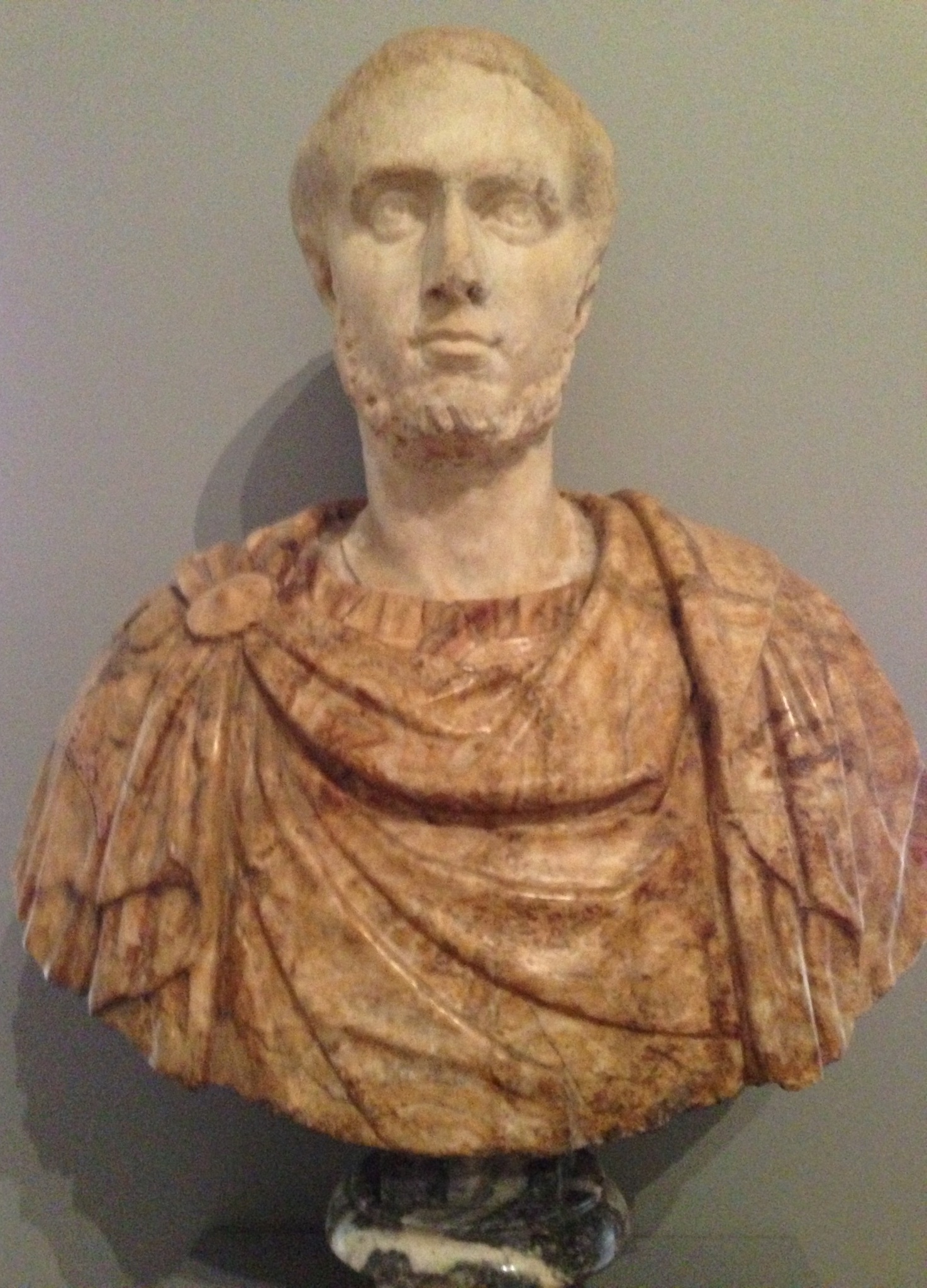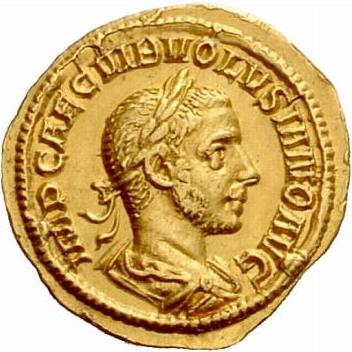1. Early Life and Family

Volusianus's early life and family connections provided the foundation for his eventual rise to imperial power.
1.1. Birth and Childhood
Volusianus was born in the early 3rd century AD. His father was Trebonianus Gallus, a Roman senator who would later become emperor, and his mother was Afinia Gemina Baebiana. Information regarding his childhood and education is limited, but as the son of a prominent senatorial family, Volusianus likely received a traditional Roman aristocratic education, which would have included studies in rhetoric, philosophy, and military arts.
1.2. Family Relations and Marriage
Volusianus was the son of Trebonianus Gallus and Afinia Gemina Baebiana. He had a sister named Vibia Galla. Volusianus was married to the unnamed daughter of the former emperor Decius, who was also the sister of Hostilian. This marriage strategically linked Volusianus to the previous imperial family, potentially bolstering his family's legitimacy and influence within Roman politics.
1.3. Family Tree
Volusianus's position within the imperial lineage is clarified by his family connections:
- Parents:** Trebonianus Gallus and Afinia Gemina Baebiana.
- Sibling:** Vibia Galla (sister).
- Spouse:** The unnamed daughter of Decius and sister of Hostilian.
- Father-in-law:** Decius, former Roman Emperor (249-251).
- Brother-in-law:** Herennius Etruscus, co-emperor with Decius (251), and Hostilian, co-emperor with Trebonianus Gallus (251).
2. Accession to Power
Volusianus's ascent to imperial power was a direct consequence of the turbulent political climate following the death of Emperor Decius.
2.1. Appointment as Caesar
In June 251, Emperor Decius and his son and co-ruler Herennius Etruscus were killed in battle against the Goths at the Battle of Abritus. Following their deaths, Trebonianus Gallus was proclaimed emperor by the legions in the field. To consolidate his position and gain popularity, Gallus initially elevated Hostilian, Decius's surviving younger son, to the rank of Augustus (co-emperor), thereby sharing power with the previous imperial family. Shortly thereafter, in July 251, Gallus appointed his own son, Volusianus, to the rank of Caesar (heir-apparent). Volusianus also received the title of Princeps Juventutis (Prince of Youth), a designation typically given to the heir to the throne.
2.2. Elevation to Augustus
The political landscape shifted rapidly with the death of Hostilian in July or August 251. The cause of Hostilian's death is debated among ancient historians; some, like Aurelius Victor and the author of the Epitome de Caesaribus, attribute it to a devastating plague, while Zosimus controversially claimed that Trebonianus Gallus orchestrated Hostilian's murder to clear the path for Volusianus. Regardless of the exact circumstances, Volusianus was subsequently elevated to the rank of Augustus, becoming a full co-emperor alongside his father. This promotion further solidified the Gallus dynasty's claim to power and aimed to ensure the continuity of their rule. Volusianus served as Roman consul in 252 alongside Trebonianus Gallus, and again in 253 with Valerius Maximus.
3. Reign
The joint reign of Volusianus and Trebonianus Gallus was marked by a series of severe challenges that tested the stability and resilience of the Roman Empire.
3.1. Joint Rule with Trebonianus Gallus
During their shared period as emperors, Volusianus and Trebonianus Gallus governed amidst an empire in crisis. Their administrative efforts were limited, as evidenced by the issuance of only two imperial rescripts throughout their reign. Both co-emperors chose to remain in Rome rather than personally confront the numerous invasions threatening the empire's borders. This decision reflected a strategy of managing the crises from the capital, possibly due to the overwhelming scale of the threats or a desire to maintain central authority.
3.2. Major Events and Threats
The Roman Empire under Gallus and Volusianus faced a confluence of major crises, including a devastating plague, relentless foreign invasions, and a critical internal rebellion that ultimately led to their downfall. These events had profound societal and economic consequences, particularly impacting vulnerable populations and border regions.
3.2.1. Impact of Plague
A severe plague, often identified as the Plague of Cyprian, ravaged the Roman Empire during their rule. This epidemic significantly weakened the population and economy, contributing to the empire's overall instability. Hostilian's death in 251 is widely attributed to this plague. In response to the crisis, Trebonianus Gallus gained considerable popularity by ensuring that all plague victims, regardless of their social status, received proper burials. While the persecution of Christians was not as extreme as it had been under Decius, it continued during this period, leading to the exile of Pope Cornelius in 252 AD and forcing Novatian to flee Rome.
3.2.2. Foreign Invasions
The Roman Empire faced simultaneous invasions from two major external forces: the Goths and the Sasanian Empire.
- Gothic Invasions:** The Goths, who had previously defeated and killed Emperor Decius, continued their incursions into Roman territory. In 253, they invaded Moesia Inferior after the new governor, Aemilian, refused to pay them the agreed-upon tribute. The Gothic forces split into two groups: one raided cities in Moesia Inferior and Thracia, while the other advanced into Asia Minor, reaching as far as Ephesus.
- Sasanian Empire:** The Sasanian Empire launched a major attack in 252, quickly overrunning Roman Mesopotamia. They decisively defeated the Romans at the Battle of Barbalissos, near the city of Barbalissos in the province of Euphratensis (modern-day Syria). The Sasanian forces then advanced deep into Roman territory, capturing Antioch in 253 after a prolonged siege. Both Volusianus and Trebonianus Gallus chose to remain in Rome rather than personally lead military campaigns against these invasions.
3.2.3. Internal Rebellions
The military successes of Roman commanders against the external threats often led to internal rebellions, as victorious generals were proclaimed emperor by their loyal troops. This was the case with Aemilian. After successfully repelling the Goths from Moesia Inferior, slaughtering many and forcing the rest back across the Danube River, Aemilian's soldiers spontaneously declared him emperor in opposition to Trebonianus Gallus and Volusianus. News of Aemilian's rebellion and his rapid march towards Rome caused significant alarm within the capital. Gallus and Volusianus attempted to rally support and called for reinforcements from Valerian, the future emperor, who was then strengthening the empire's defenses along the Rhine River. However, Aemilian's forces advanced quickly, reaching Italy before Valerian could send any assistance.
4. Numismatics

The coins, particularly the aureus, issued during Volusianus's reign provide valuable insights into imperial propaganda and economic activity of the period. These coins generally fell into two main types based on their obverse designs.
One type featured Volusianus's bust on the obverse, with the reverse displaying various allegorical figures:
- Aequitas (Equity) sitting.
- Aeternitas (Eternity) standing.
- Apollo (God of light and music) standing.
- Juno (Queen of the Gods) sitting inside a rounded temple.
- Victoria (Victory) standing.
A second type of coin featured Volusianus's bust adorned with a Radiate crown on the obverse. The reverse of these coins depicted:
- Concordia (Harmony) sitting.
- Felicitas (Good Fortune) standing.
- Libertas (Liberty) standing.
- Providence (Foresight) standing.
- Salus (Safety/Well-being) standing.
- A helmeted Virtus (Valor) standing.
Inscriptions on Volusianus's coins occasionally bore the phrase Saeculum nouum (new age), alongside more traditional inscriptions such as Romae aeternae (eternal Rome) and Pax aeternae (eternal peace). These inscriptions and imagery were intended to project an image of stability, prosperity, and divine favor, despite the empire's ongoing crises.
5. Death
The reign of Volusianus and Trebonianus Gallus came to an abrupt and violent end in August 253. As Aemilian's forces rapidly advanced towards Rome, the troops loyal to Gallus and Volusianus became terrified of confronting the usurper's much stronger army. Rather than face battle, their own soldiers mutinied. In a act of betrayal, they killed both Trebonianus Gallus and Volusianus at Interamna, located in Umbria, Italy. This assassination paved the way for Aemilian to briefly seize the imperial throne, though he himself would suffer a similar fate only a few months later. According to the Chronography of 354, Volusianus and his father had ruled for a total of two years, four months, and nine days.
6. Historical Evaluation and Legacy
Volusianus's reign, though brief, is largely defined by the severe challenges that characterized the Crisis of the Third Century. He ruled during a period of intense instability, marked by relentless barbarian invasions, devastating plagues, and frequent internal rebellions. His co-emperorship with his father, Trebonianus Gallus, saw the Roman Empire grappling with major external threats from the Goths and the Sasanian Empire, as well as the societal and economic collapse brought on by the Plague of Cyprian.
Historians generally view Volusianus's time in power as one of imperial weakness and reactive governance, particularly given the co-emperors' decision to remain in Rome rather than personally lead military campaigns against the invaders. While his father gained some temporary popularity for his handling of plague burials, the overall imperial response to the era's crises was perceived as inadequate. The continued, albeit less severe, persecution of Christians during their rule also reflects a period of religious tension. Ultimately, Volusianus's legacy is inextricably linked to the violent circumstances of his death, which underscored the precarious nature of imperial power during the mid-3rd century, where military loyalty was fleeting and usurpers frequently emerged from the ranks. His reign serves as a testament to the profound internal and external pressures that nearly brought the Roman Empire to its knees.